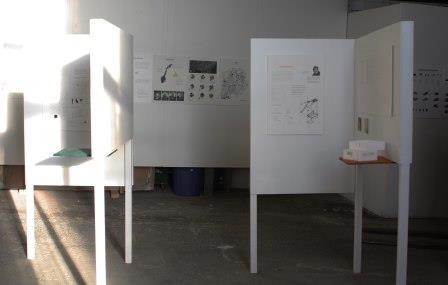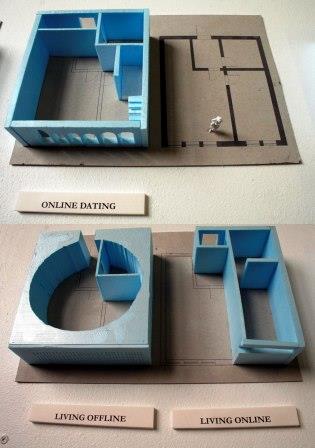Diploma 2013: “The Subject at Home" by Linn Kopperdal
- spatial explorations on ubiquitious dwelling
Tutors: APP Deane Simpson, DAV Vibeke Jensen
This Diploma addresses the theme of the increased use of Electronic Media and Communication and its spatial and social impact on dwelling in a contemporary Norwegian context. Has the introduction and the way in which the day-to-day useof electronic media been part of reorganizing the social settings in which people interact and thus, can it be said to be weakening the once strong relationship between physical “space/place” and social “space/place”? What are the possible spatial implications of this transformed way of life?
This Diploma investigates different ways of looking at the Human Subject as the starting point for the design of dwellings. Such an exercise refers to figures such as Le Corbuser’s “modular man”, who drew on earlier work of those such as da Vinci and Battista Alberti, who looked at the mathematical proportions of the body to create the ideal proportions for living spaces.Whereas the modular man reflected a modernist theory of rationalised living, and rationalised space, the modular man’s counterpart today is perhaps not restrained only to bodily physical restrictions, but also enabled by the extended boundaries that the constant use (or mis-use and non use) of electronic communication offer. We do not only live together in apartments as families, where we cook, sleep, bath and enjoy green common spaces – today we tend increasingly to live alone (20 % of Norwegian population). We use our homes, the spaces we inhabit, in different ways, in different rhythms, and of course, our bodies are not the measurements or gender of an early 20th Century european man.
Based on research (literature review, interviews, talks, media coverage andstatistical data) on the use of electronic communication in contemporary Norway, five different phenomena and types of subjectivity become more prominent. I have given them the names of InstaGirl, MiniWeb, TimeOff, WorkAHolic and OffTheGrid,and detected the specific architectural needs for their dwelling situations. These ive typologies have been combined as an experiment in a prototypical housing typology addressing these particular forms of subjectivity. The provisional context for this prototype is the Sagene neighbourhood of Oslo, where 63 % of the population live alone and the demographic profile suggests a heavily online population.
InstaGirl For the last years the most read blogg in Norway has been http://tcmn.blogg.no/, the blogg of an 18 year old girl exposing her everyday life online. She has 74 000 followers on InstaGram, 28 627 follower and 3020 friends on FaceBook. She has got silicon in her breasts and restylan in her lips: for many people she is the dream come true, for others the symbol of what has gone wrong in the society today. Download pdf about InstaGirl, and Section 1:100.
All photos by Linn Kopperdal
OffTheGrid
As we constantly are being exposed to multimedia surfaces and objects
new lifestyle illnesses are emerging and a growing number of people are
now questioning this way of life. The last typologyhave taken a distance from this digital urban
life, with a which to live in a world where the internet does not reach.
Together with the transition from mechanicalproduction to brain production, the
introduction of electronic communication and media offers the ability to work from
more or less anywhere, and more or less at any given time of the day. With smart phones
one can even read the work email while on the toilet, and thus never having the space to
“clock out”.

Miniweb is the typology that draws on the increased use of online gaming, where people
play for days without stopping and perhaps never even leaving the house. Some scientist
say this activity is anti-social, others say it is the opposite. No matter which of the above
who are right, the time spent online with games is increasing year by year.
Drawing on the philosophical question of the tree that falls in the woods and the sound
it makes or not, this typology emerged from the question: If one go on a run and don’t
post pictures of it on a social medium, has it really happened? As Norwegians statistically
get more and more leisure time, the pressure seems to be that this time best be spent on
exercising and eating healthy.

